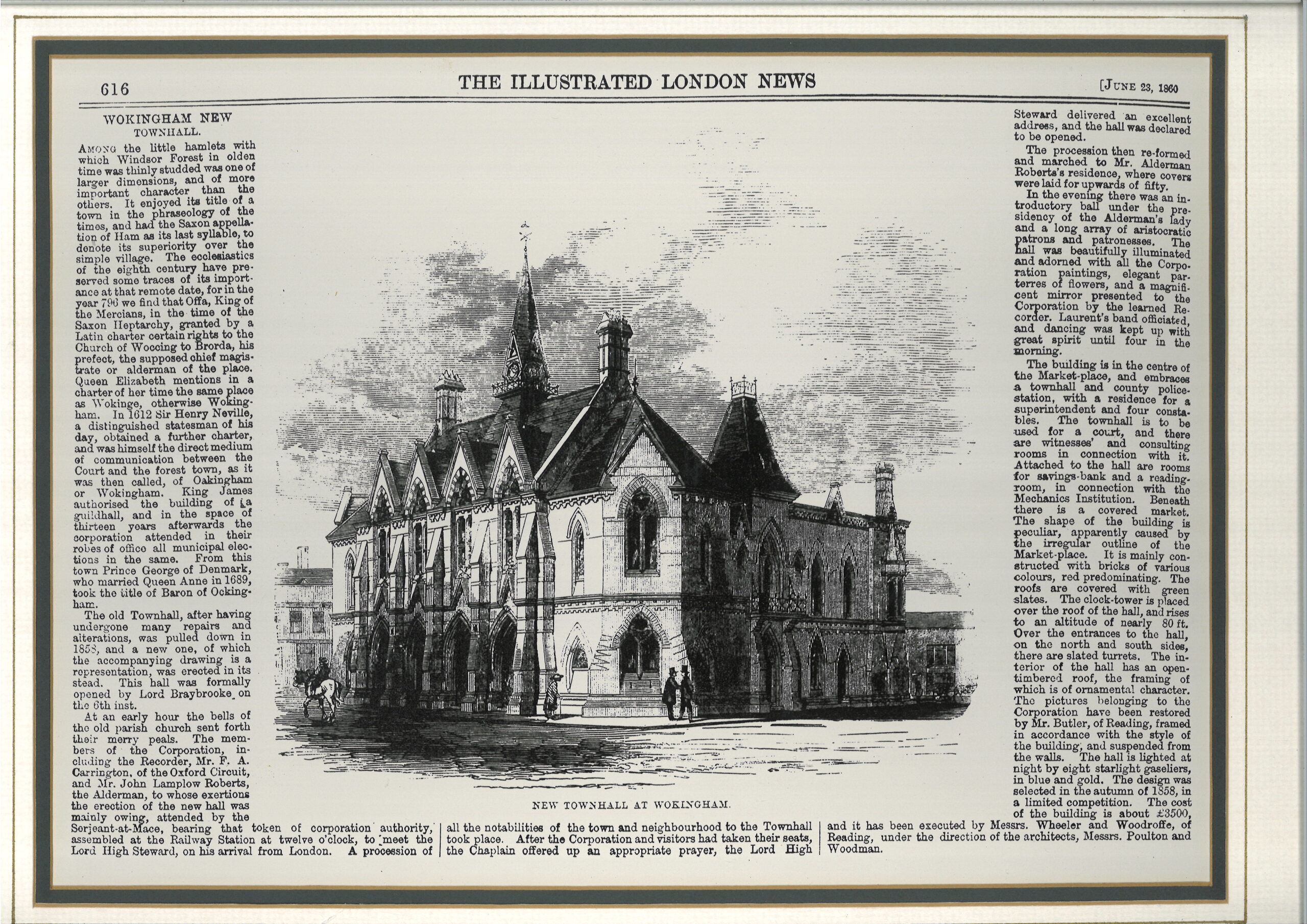A framed copy of the ” Illustrated London News” reporting on the opening of the Town Hall on 6th June 1860.
The new town hall was officially opened with much pomp and ceremony by the High Steward of Wokingham, Richard Cornwallis Neville, 4th Lord Braybrooke. The Mayor and members of the Corporation paraded to the railway station where they welcomed the High Steward. The dignitaries then paraded to the Town Hall where after numerous speeches, the new building was officially inspected and opened. After the ceremonies everyone of importance had lunch at Alderman Robert’s house.
That evening a ball was held in the town hall for the local dignitaries and their wives. Admission was 10 shillings for the ladies and 15s for the gentlemen.
There follows the wording from the Illustrated London News: –
“Wokiingham,, among the little hamlets with which Windsor Forest in olden time was thinly studded was one of the larger dimensions, and of more important character than the others.. It enjoyed its title of a town in the phraseology of the times, and had the Saxon appellation of Ham as its last syllable to denote its superiority over the simple village. The ecclesiastics of the eight century have preserved some traces of its importance at that remote date, for in the year 796 we find that Offa, King of the Mercians, in the time of the Saxon Heptarchy, granted by a Latin charter certain rights to the church Woccing to Broda, his or prefect, the supposed chief magistrate or alderman of the place. Queen Elizabeth mentions in a charter of her time the same place as as Wokinge, otherwise Wokingham. In 1612 Sir Henry Neville, a distinguished statesman of his day, obtained a further of charter, and was himself the direct medium of communication between the Court and the forest town, as it was called Oakingham or Wokingham. King James authorised the building of a guilhall and in the space of thirteen years afterwards the corporation attended in their robes of office all municipal election in the same. Fromn this town Prince George of Denmark, who married Queen Anne inn 1689 took the title of Baron of Oakingham..The old Townhall, after having undergone many repairs and alterations, was pulled down in 1558, and a new one, of which the accompanying drawing is a representation, was erected in its stead., The hall was formally opened by Lord Braybook on the 6th inst. At an early hour the bells of the old parish church sent forth their merry peals. The members of the Corporation, including the Recorder, Mr. F. A. Carrington, of the Oxford Circuit, Mr. John Lamplow Roberts, the Alderman, to whose exertions the exertions the erection of the new hall was mainly owing, attended by the Serjeant-at-Mace, bearing that token of coporatoin assembled at the Railway Station at twelve o’clock , to meet the Lord High Steward, on his arrival from London. A procession of all the notabilities of the town and neighborhood to the Town hall took place. After the Corporation and visitors had taken their seats, the Chaplain offered up an appropriate prayer, the Lord High Steward delivered an excellent address, and the hall was declared to be opened.
The procession then re-formed and marched to Mr. Alderman Robert’s residence, where covers were laid for upwards of fifty. In the evening there was an introductory ball under the presidency of the Alderman’s lady and a long array of aristocratic patrons and patronesses. The hall was beautifully illuminated and adorned with all the Corporation paintings, elegant parterres of flowers, and a magnificent mirror presented to the Corporation by the learned Recorder. Laurent’s band officiated, and dancing was kept up with great spirit until four in the morning. The building is in the centre of the Market Place, and embraces a townhall and county police station, with a residence for a superintendent and four constables. The townhall is to be used for a court, and there are witnesses and consulting rooms in connection with it. Attached to the hall are rooms for savings bank and a reading room in connection with the Mechanics Institution. Beneath there is a covered market. The shape of the building is peculiar, apparently caused by the irregular outline of the Market Place. It is mainly constructed with bricks of various colours, red predominating. The roofs are covered with green slates. The clock tower is placed over the roof of the hall, and rises to an altitude of nearly 80 ft. Over the entrances to the hall, on the north and south sides, there are slated turrets. The interior of the hall has an open timbered roof, the framing of which is of ornamental character. The pictures belonging to the Corporation have been restored by Mr. Butler, of Reading, framed in accordance with the style of the building, and suspended from the walls. The hall is lighted at night by eight starlight gaseliers, in blue and gold. The design was selected in the autumn of 1858, in a limited competition. The cost of the building was £ 3500,and it was executed by Messrs.. Wheeler and Woodoffe of Reading, under the direction of the architects, Messrs. Poulton and Woodman.
Wokingham Town Museum Unique Identifier: WTH0224

